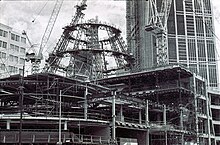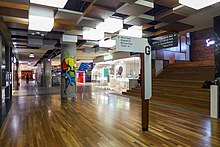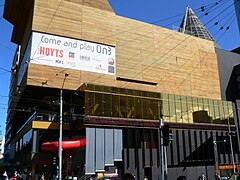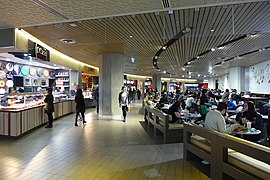 | |
 | |
| Location | Melbourne, Victoria, Australia |
|---|---|
| Coordinates | 37°48′37.42″S 144°57′47.32″E / 37.8103944°S 144.9631444°E / -37.8103944; 144.9631444 |
| Opening date | September 1991; 33 years ago (September 1991) |
| Developer | Kumagai Gumi |
| Management | GPT Group |
| Owner | GPT Group |
| Architect | Hassel P/L with Kisho Kurokawa (1991), Ashton Raggatt McDougall (2002-2005 & 2010-2011) |
| No. of stores and services | 276 |
| No. of anchor tenants | 2 |
| Total retail floor area | 55,700 square metres (600,000 sq ft) |
| No. of floors | 6 |
| Parking | 876 |
| Public transit access | Melbourne Central railway station, trams, buses |
| Website | melbournecentral |
Melbourne Central is a large shopping centre, office, and public transport hub in the central business district of Melbourne, Victoria, Australia. The main tower is 211-metre (692 ft) high, making it one of the tallest buildings in Melbourne at the time it was built in 1991. Other parts of the complex include the Melbourne Central Shopping Centre, the underground Melbourne Central railway station and the heritage-listed Coop's Shot Tower.
The site of the present-day complex was earmarked for development in the early 1970s by the Melbourne City Council. At the time, the State Government of Victoria had started constructing the City Loop underground railway with a station located on the site called Museum Station. The main tower and complex was completed in 1991, designed by Japanese architect Kisho Kurokawa and the Kumagai Gumi architecture firm at a cost of $1.2 billion. It has since been significantly renovated three times in 2001, 2005 and 2010.
Today the centre features a gross leasable area of 55,100 square metres (593,000 sq ft) spread over six floors. The 20 storey glass conical structure over the Coop's Shot Tower is the largest of its kind in the world and over 8.6 million passengers pass through the Melbourne Central station every year.
History
Background
Originally termed the 'Victoria Project', large scale redevelopment of the city block bounded by Lonsdale, Swanston, La Trobe and Elizabeth Streets was studied in some detail during the 1960s and 1970s, being closely linked with work on the City Loop Early work on the site commenced in 1971 when land on the south side of La Trobe Street was acquired, to enable the cut and cover construction of Museum Station (now known as Melbourne Central). With planning for the site being carried out by the Melbourne Underground Rail Loop Authority from 1980, the railway station opened in 1981, but protracted negotiations failed to find an anchor tenant for the development, resulting in the State Government of Victoria deciding in 1983 that a private developer should be sought.

Design
By the time registrations closed in March 1984 a total of 28 submissions had been received from developers, with eight selected organisations invited to respond. A government panel sat in April 1985 to evaluate the responses, and one month later announced their preferred scheme: designed by Hassell Architects for EKG Developments, a joint venture between Australian property developer Essington Limited and Japanese construction firm Kumagai Gumi. The project compromised an 85 floor office tower, with a hotel at the Swanston Street end, joined by a huge sloping walled atrium 20 floors high, over a shopping atrium opening down to the station platforms, designed by Hassell.
The $1.2 billion contract was signed soon after but without Essington Limited, who were removed by the State Government after a number of directors were linked to the Nugan Hand Bank. It was also at this time that Kisho Kurokawa was brought on board as architect, with Hassell and Bates, Smart & McCutcheon compensated by becoming the joint documenters of the scheme. It was also scaled back, with the hotel removed, and the office tower reduced to 72 storeys and then 55, and the atrium reduce to a tall cone, and a circular opening through the shopping levels. An arm of shops connecting to Lonsdale Street was also added, replacing 19th century warehouses, and via footbridges connected through to the Myer store. An anchor tenant was also found, with Japanese department store Daimaru signed on over six floors of the shopping centre due to the involvement of the Japanese Sumitomo Bank on the project. Connell Wagner were the civil and structural engineers for the project. Mechanical, electrical and hydraulic services were provided by Norman Disney & Young. Rankin & Hill did the fire services.
Opening (1991)
Melbourne Central opened to great fanfare in 1991 with over 150 stores and the Daimaru anchor tenant attempting to compete with local, established department stores Myer, Georges and David Jones. The original six stores of retail were organised into five different areas called 'shopping worlds' - Historic World, Crystal World, Action World, Urban World and International World. Its huge size and introduction of new, novel technology, defined its attempts to attract customers from across metropolitan Melbourne. This included Australia's largest inner-city carpark with space for over 1,600 cars, automatic reduction of fees for parking and childcare based on the amount of money spent in the shopping centre, and a three-storey glass butterfly enclosure and waterfall.
First redevelopment (2002 - 2005)
The centre never became profitable for owner Kumagai Gumi, who sold 97.1 per cent to Australian property manager GPT Group for $408 million in 1999, retaining 2.9 per cent to write the asset off over 20 years. Kumugai abandoned this plan in 2001, selling their remaining share to GPT for $17 million.At the same time, Daimaru closed their department store in 2002, paying $30 million for their five years of remaining rent in return for abandoning their lease commitment which ended in 2016. Daimaru never turned a profit on the store, costing its shareholders approximately $200 million. With half the total retail space empty due to the loss of Daimaru, GPT announced a $195 million plan to renovate the centre in April 2002. Eventually costing $260 million, the renovated centre with a postmodern design by architects Ashton Raggatt McDougall and ARM Architecture who described it as a "tired, old building", inappropriate for Melbourne. It aimed to open the complex to more natural light, new street-front shopping strips, and bubble-like additions to the footbridge across Little Lonsdale Street, but largely compromised the design of Kurokawa. The works also compromised access to the adjacent Melbourne Central railway station, removing direct access to Swanston Street and directing passengers through the shopping centre. The renovation took the book value of the complex to $1033 million in 2010, up from $229.8 million as of at 31 December 2001.
Second redevelopment (2010-2011)
In 2010 plans for a second $75 million redevelopment were unveiled by GPT. This was done in two stages, with the first costing $30 million. Using the same Ashton Raggatt McDougall Architects from its 2002 - 2005 redevelopment, these new plans called for more new entrances and retail precincts. This included new food shops on the western side and a new side entrance from Swanston Street near the intersection with La Trobe Street. New entrances through Knox Lane from Elizabeth Street were also built to create another cross-block connection through the precinct. The food court on Level 2 called 'Food on Two' was closed in 2011 as part of this redevelopment. It was replaced with a larger food court, called the 'Dining Hall', opened in the first stage of the 2010-2011 redevelopment.
Criticism

During the early stages of planning in the late 1960s and early 1970s, the lack of certainty on the site's future was criticised by some existing property owners, residents and business operators due to the perceived negative impact on land values. Confirmed design intentions were not publicly revealed until 1985 following a lengthy tender evaluation and committee process. There was criticism throughout the design and construction phases of the complex's impacts on heritage and neighbourhood character. At the time of its early planning the prevailing attitude from government planners was that the traditional layout of the central city with small laneways and buildings was old-fashioned and not suited to a modern metropolis. This was reflected in the final design of the complex as a single building using almost an entire city block. As a result, four laneways and many other buildings were demolished to make way for the new structures.
Although generally acknowledged as a successful design and development, several groups and individuals criticised certain aspects of the building. For example, the Victorian Chamber of Commerce, National Trust of Australia and heritage preservation groups opposed the link bridges between Melbourne Central and the Myer department store on the grounds that it would discourage people from walking at street level and reduce patronage to smaller businesses. Further redevelopment of the centre in 2002 and 2003 has a significant impact on access to the now-renamed Melbourne Central railway station. The original complex design featured a direct entrance to the underground concourse from the tram stop on Swanston Street, the busiest section of tram track in the world. The company operating Melbourne's suburban railways at the time, M>Train, together with the owners of Melbourne Central, closed this direct entrance in favour of a much longer route through the shopping centre. This caused overcrowding and delays to passengers attempting to access the station platforms.
Complex
Office tower
| Melbourne Central Office Tower | |
|---|---|
| General information | |
| Type | Office |
| Location | Elizabeth Street, Melbourne CBD, Victoria, Australia |
| Height | |
| Antenna spire | 246 m (807 ft) |
| Roof | 210 m (690 ft) |
| Technical details | |
| Floor count | 57 |
The Melbourne Central Office Tower tops out at 210 metres (690 ft) with 57 storeys, 46 of which are for office use. Currently it is occupied by ME Bank replacing space previously tenanted by BP and Telstra. Several Australian and Victorian Government departments and agencies maintain spaces in the tower including Creative Australia, the Department of Infrastructure, Transport, Regional Development, Communications and the Arts and the Victorian Energy & Water Ombudsman. Other tenants include Wilson Parking, Nordex and Pacific Basin Shipping Limited The tower is owned by GPT Wholesale Office Fund and the tower structure is approximately 210 metres (690 ft) tall. Including the two 54-metre (177 ft) communications masts that extend a further 35 metres (115 ft) above the apex, the tower is 246 metres (807 ft) tall.
| List of tallest buildings in Australia | |||||
|---|---|---|---|---|---|
|
| ||||
| Heights are to highest architectural element. | |||||
| List of tallest buildings in Melbourne | |||||
|---|---|---|---|---|---|
|
| ||||
| Heights are to highest architectural element. | |||||
Coop's Shot Tower

The Coops Shot Tower was built in 1888 and used for making shot balls by dropping liquid lead off the top of the 50-metre (160 ft) high structure. After last being used in 1961, the tower was retained after being heritage listed to become a focal point and symbol of Melbourne Central itself.
It is enclosed by a 80-metre (260 ft) high glass cone, built when the complex was constructed in 1991. It weighs 490 tonnes and has 924 glass panes. The cone is the largest of its kind in the world and was built in reference to the large dome of the adjacent State Library of Victoria. The glass panes are cleaned by a specially designed mechanical system. Upon the centre's opening it was referred to as the "Magic Cone".
The tower now contains the Shot Tower Museum and retail stores R.M. Williams, Supré and DJI and was featured in the opening sequence of the 1997 Jackie Chan film Mr. Nice Guy.
The Marionette Watch

The watch, designed by Seiko, was given as a gift to the people of Melbourne. When it was unveiled together with the rest of the complex in 1991, the watch had a twelve and a half metre, two tonne chain. This is no longer attached as it was removed during the centre's refurbishment in 2002 and not replaced.
Every hour, on the hour, a marionette display drops down from the bottom of the watch with Australian galahs, cockatoos and two minstrels performing Waltzing Matilda, under the watchful gaze of some koalas. The Seiko branding has since been removed.
The Vertical Garden

A vertical garden was installed on the side of the Coop's Shot Tower as part of the Melbourne International Design Festival in July 2008. Pioneered by internationally renowned French artist and scientist, Patrick Blanc, the garden had no soil and was attached to the wall using PVC plastic. However, the running cost proved expensive and in 2013 it was replaced with an advertising billboard.
Retail


Melbourne Central currently has 276 retail shops and services. Its current two anchor tenants, Hoyts Cinemas and Coles, each occupy 7,710 square metres (83,000 sq ft) and 1,310 square metres (14,100 sq ft) of space respectively.
Other key tenants include adidas, Sephora, JD Sports, Platypus Shoes, Country Road, R. M. Williams, Cotton On, Lego Certified Store, JB Hi-Fi, Rebel Sport, Under Armour, Nike, Supré, MECCA, DJI and Calvin Klein.
A large portion of the centre is dedicated to food and beverage outlets. These are concentrated in two food courts and one covered outdoor walkway. These are:
- Food court on the Lower Ground Floor
- ELLA on the Ground Floor near Elizabeth Street
- Dining Hall on Level 2
Hoyts Cinema, the Melbourne Central Lion Hotel, entertainment venues and various restaurants and bars make up Level 3 of the centre.
There is a multi-level glass footbridge across Lonsdale Street to Myer, with the layout of the centre allowing people to walk almost uninterrupted through some form of a shopping centre for over half of the city's width or 5 city blocks, from La Trobe street to Little Collins Street. This occurs via Melbourne Central which joins to Myer which in turn joins to David Jones over Bourke Street Mall. The glass footbridge was closed when Myer Melbourne vacated their Lonsdale store building. The footbridge re-opened in April 2014 when the Emporium Melbourne shopping centre opened.
Gallery
-
 Main entrance podium, corner La Trobe and Swanston Streets after re-development.
Main entrance podium, corner La Trobe and Swanston Streets after re-development.
-
 Melbourne Central, Lonsdale Street entrance, below bridge to Myer Melbourne.
Melbourne Central, Lonsdale Street entrance, below bridge to Myer Melbourne.
-
 Underneath the iconic glass cone
Underneath the iconic glass cone
-
 Food On 2 level Food Court
Food On 2 level Food Court
-
Various floors in central area. (2010)
-
The Marionette Watch
-
 Photo of the Basement level in Melbourne Central looking towards Melbourne Central Station after refurbishment.
Photo of the Basement level in Melbourne Central looking towards Melbourne Central Station after refurbishment.
See also
References
- Building Profile Archived 21 November 2011 at the Wayback Machine, Melbourne Central Tower
- ^ Retail Archived 14 November 2012 at the Wayback Machine, The GPT Group
- ^ "GPT – 2023 ANNUAL RESULT PROPERTY COMPENDIUM" (PDF). GPT Group. Retrieved 27 May 2024.
- "Melbourne Central > Stores > Centre Maps". Archived from the original on 24 January 2009. Retrieved 9 July 2011.
- ^ "Melbourne Central Heritage". Melbourne Central Shopping Centre. GPT. Retrieved 24 May 2024.
- ^ Institute of Technology Bandung Java (September 1995). "Melbourne Central a Case Study in Post-Modern Urbanization". Archived from the original on 28 September 2011. Retrieved 26 September 2011.
- ^ Philip Hopkins (23 June 2010). "Retail revamp for Melbourne Central". The Age. Retrieved 26 September 2011.
- "Annual metropolitan train station entries 2022-23". Data Vic. Victorian Department of Transport & Planning. Retrieved 24 May 2024.
- McLoughlin, J. Brian (1992). Shaping Melbourne's future? town planning, the state, and civil society. London; New York: Cambridge University Press. p. 80. ISBN 9780521439749.
- The largest redevelopment in Australia's history (Development brochure). Victorian Government. 1985.
- ^ Ryan, Denise (8 September 1991). "Birth of a Department Store". The Age. p. 19. Retrieved 28 May 2024.
- "Warehouse group". Victorian Heritage Database. Retrieved 10 February 2023.
- Georgiev, Peter (April 1991). Architect - "The Speculative City: Melbourne Central". Royal Australian Institute of Architects (RIAA).
- "Confident Daimaru opens huge store". Australian Financial Review. 10 September 1991. Retrieved 10 February 2023.
- ^ Peter Semple (17 April 2002). "Melbourne Central set for makeover". The Age. Retrieved 26 September 2011.
- Corrie Perkin (23 June 2002). "The refashioning of Melbourne Central". The Age. Retrieved 26 September 2011.
- "Daimaru prepares for a last hurrah". The Age. 3 June 2002. Retrieved 10 February 2023.
- "Melbourne Central renovation". The Age. 30 August 2005. Retrieved 29 May 2024.
- ^ "Melbourne Central set for retail revamp". InvestSMART. 23 June 2010. Retrieved 29 May 2024.
- "Melbourne Central opens vibrant new food precinct | IR News | Inside Retail". Archived from the original on 1 October 2011. Retrieved 9 July 2011.
- Bate, Weston (1994). Essential but unplanned: the story of Melbourne's lanes. Melbourne: State Library of Victoria. p. 16. ISBN 9780730635987.
- Mahlab, Bobbi (27 August 1989). "Business body opposes bridge plan". The Age. Retrieved 24 May 2024.
- Guthrie, Susannah (30 May 2023). "This is officially the busiest intersection in Melbourne". Drive. Drive.com.au. Retrieved 24 May 2024.
- "Melbourne Central Closure Study Flawed, Say Users". Public Transport Users Association. Retrieved 24 May 2024.
- "Melbourne Central set to prey on captive commuters". The Age. 4 November 2003. Retrieved 24 May 2024.
- Tivendale, Knowles. "CBD Pedestrian Congestion - Public Transport Access" (PDF). City of Melbourne. Tivendale Transport Consulting. Retrieved 24 May 2024.
- "GPT secures ME Bank & Allianz - Australian Property Journal". Australian Property Journal. 14 July 2010. Retrieved 27 May 2024.
- "The GPT Group > Announcements & Media Releases". Archived from the original on 30 September 2011. Retrieved 10 July 2011.
- ^ "Customer Directory". Melbourne Central Tower. Retrieved 27 May 2024.
- "Melbourne Central Tower - the Owners". Archived from the original on 19 February 2011. Retrieved 10 July 2011.
- "Archived copy" (PDF). Archived from the original (PDF) on 26 March 2012. Retrieved 10 July 2011.
{{cite web}}: CS1 maint: archived copy as title (link) - Sides, Carol (2 February 1982). "Looking at the Melbourne many people do not know". The Age. p. 20. Retrieved 26 April 2011.
- "MELBOURNE CENTRAL'S HERITAGE THE COOP'S SHOT TOWER IN 1889". www.melbournecentral.com.au. Melbourne Central. Retrieved 28 May 2024.
- "Open House Melbourne: top things to book". Australian Design Review. Retrieved 29 May 2024.
- Kinsey, Melanie (19 August 2009). "Raising the roots". The Sydney Morning Herald. Retrieved 31 May 2024.
- Paul, Mark. "Greenwalls – latest fashion or much more |". Garden Drum. Retrieved 31 May 2024.
- "Centre Map - Melbourne Central". www.melbournecentral.com.au. Retrieved 31 May 2024.
- Notes
External links
| Landmarks in the Melbourne central business district | |
|---|---|
| Note: this includes landmarks in the Melbourne central business district and its immediate surrounds, not the Greater Melbourne metropolitan area | |
| Precincts | |
| Entertainment | |
| Shopping centres | |
| Public museums | |
| Institutions | |
| Notable structures | |
| Sports venues |
|
| Parks and gardens | |
| Transport | |
| Shopping centres in Victoria | |||||||||||
|---|---|---|---|---|---|---|---|---|---|---|---|
| |||||||||||
| List of shopping centres in Australia List of largest shopping centres in Australia | |||||||||||
| Skyscrapers in Melbourne over 150 metres in height | ||||||||||||||
|---|---|---|---|---|---|---|---|---|---|---|---|---|---|---|
|  Melbourne skyline in 2015 Melbourne skyline in 2015 | |||||||||||||
| ||||||||||||||
| ||||||||||||||
| ||||||||||||||
| ||||||||||||||